Release Date : February 4, 2022
Developers : Techland
Publisher : Techland
Platforms : PS4, PS5, Xbox One, Xbox Series X/S, PC, Nintendo Switch
Finally, here it is, Dying Light 2. Born on the ashes of Dead Island, Dying Light was an amazing success, managed to ensure certain durability, and generated a lot of interest in the zombie survival community, which was quickly saturated as the industry kept regurgitating it ad nauseam. Successful follow-up, Spin-off battle Royal unfairly underrated with Dying Light Bad Blood… the franchise has never really left the radar of gamers and comes back today with an episode 2 that is loaded with ambitions. It took 6 years of hard development to bring Dying Light 2 to life, and all that effort and determination has paid off.
An update on the old gen versions
Most of our test sessions were performed on PC, but we had the opportunity to play Dying Light on PS4 Pro and PS4 Fat for a little over two hours. No need to keep the suspense going, these versions are solid. Of course, on these two machines, the visual rendering is much less brilliant than on PC and some micro freezes or animation bugs, never disturbing, were present during our sessions. However, overall, the experience was very fluid, the loading times were quite acceptable and finally, Dying Light 2 is perfectly playable on these versions. So, an excellent point.
WELCOME TO VILLEDOR
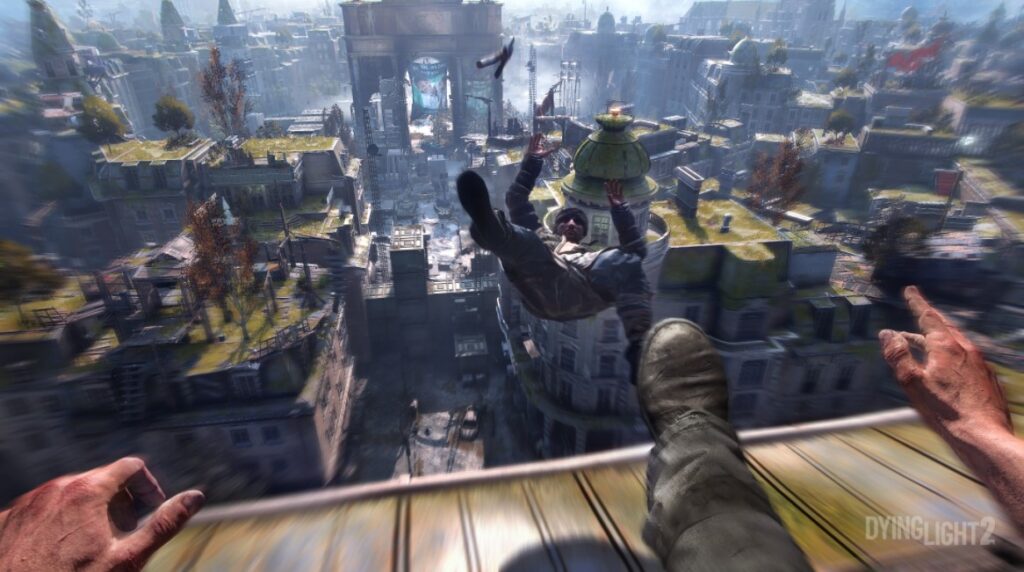
The events of Dying Light 2: Stay Human take place about twenty years after the first opus. The state of affairs is not very exciting. The virus that transforms the population into infected has ravaged most of the survivors, who now live in isolated outposts of the outside world. However, one city has organized itself and is now one of the last surviving towns of humanity: Villedor. Despite the walls that protect it, the city is not a safe haven either, and in addition to the infected that still swarm the streets, other conflicts threaten the balance of the city.
While the survivors try to unite to collect the food they need to survive, a self-proclaimed militia united under the name of “Peacekeeper” tries as much as possible to centralize vital resources and protect a population that has asked for nothing. Beyond the struggle between these two factions, you play as Aiden, a pilgrim. Your hero, with his unusual resilience and ability to survive beyond the city walls, is on a quest to find his little sister, from whom he was separated in the fire that destroyed the hospital where they were both held captive. This quest will lead him to Villedor, where he will meet a whole gallery of characters and, as you can imagine, become involved in internal conflicts that he had not foreseen.
A REINFORCED NARRATIVE IN A COHERENT OPEN WORLD
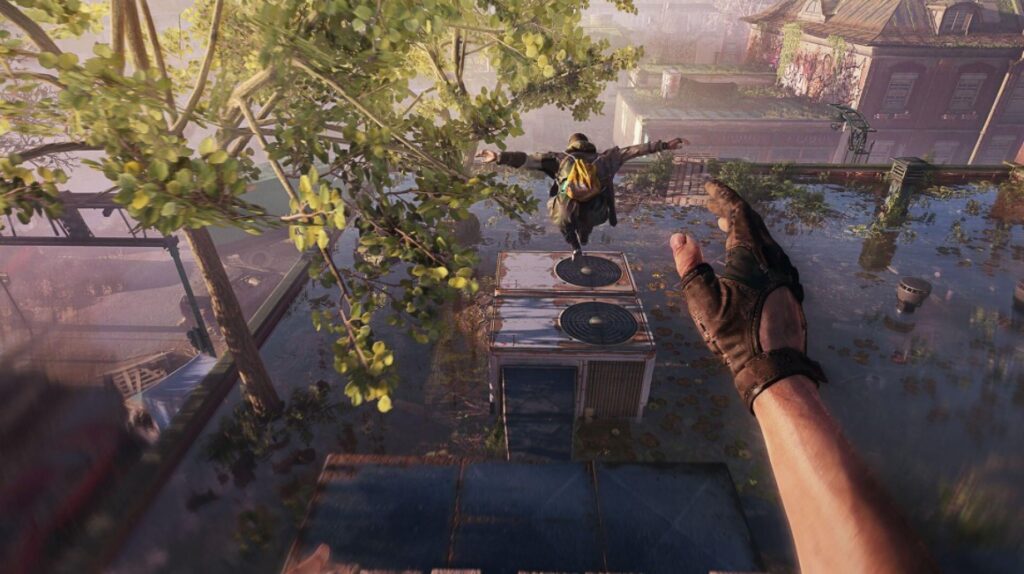
Before even mentioning the gameplay of Dying Light 2, it’s worth mentioning its stated intention to reinforce the narrative dimension of its plot. Whether it’s in the environments you cross or the smallest side quest you start, you can feel Techland’s will to give substance to its universe, in a way that is more pronounced than in the first part of the franchise. If Dying Light has always wanted to move away from the simple survival game by offering more detailed stakes than most of its competitors, this second installment pushes the envelope.
Rich in twists and turns, the main plot of Dying Light 2 is very well-paced and its narrative, a bit hesitant in the first hours, manages to refine itself to actively involve the player in its development. Although we can recognize a few weaknesses in the writing (the flashbacks, in particular), a few shots that could have been avoided, or some predictable turns, this narrative shift in Dying Light 2 is a success that needs only a little finesse to be perfect. Techland has chosen to involve the player in its universe, and it’s very common that his choices will be taken into account in the medium or long term, so that the global orientation of the main storyline is impacted.
The ending may be a bit binary, but the way to get there may differ from one player to another. Supporting a particular faction or preserving your own interests instead of the common good are some of the dilemmas you will face and which you will have to deal with the consequences, partially at least. Don’t expect the plot to be completely changed, but your actions and decisions will be taken into account in the game and you will be surprised that a choice you thought was harmless can be remembered hours later. The same effort has been put into the side quests. No, not all the ones you accept will be breathtaking, but most of them have been given special care so that they don’t feel like simple Fedex missions. Some of them have a few drawers and surprises that match the best moments of the main quest without a second thought.
With a few exceptions, the side content has benefited from a real sense of writing, just like the game’s universe, which is as vast as it is coherent. The game is also quite dynamic, and random encounters will allow you to rescue survivors, or groups trying to fend off some zombies. In addition to this, the sound environment is particularly well designed, ranging from the simple cry of a baby to the sounds of a fight in an apartment you can never get into, and you will understand that Villedor is a universe in which it is very easy to immerse yourself.
A STRUCTURE THAT WORKS
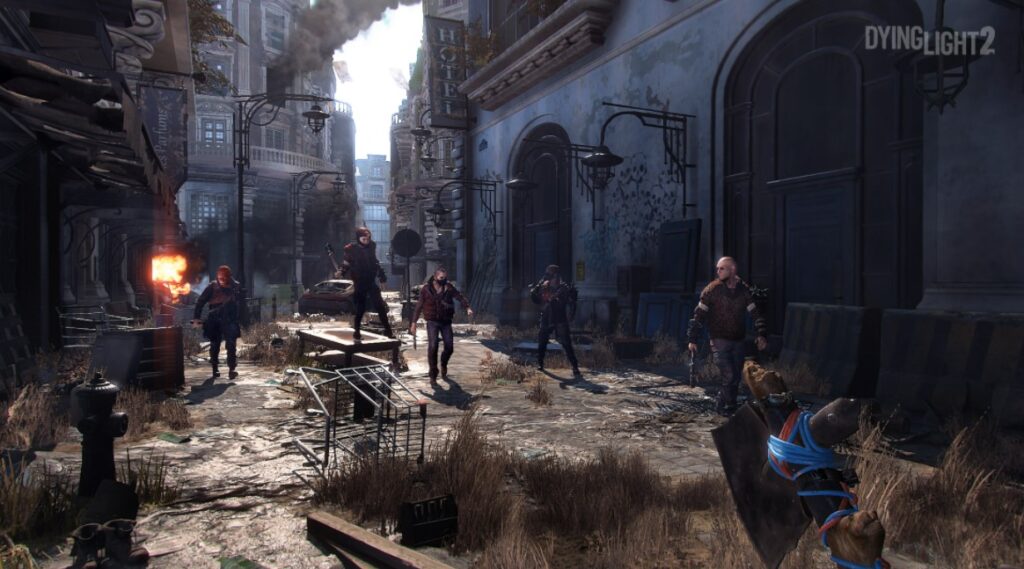
Dying Light 2, before its release, was essentially numbers. 500H of content announced not without a hitch (a length we’ll come back to), and also a map 4 times bigger than the first episode of the saga. In fact, yes, Dying Light 2 is huge and it is indeed a connected open world with no loading times, even if it won’t be immediately possible to go from one end of the map to the other when you first set foot on it. You’ll have to wait a little while before accessing the areas, which are connected by vast chemical zones, and cannot be crossed without a minimum of experience. Dying Light 2 takes the traditional open-world mechanics in its stride and, rather than letting you go wherever you want from the start, it prefers to let you walk around a vast starting area and let the story take you further, gradually introducing new mechanics that will let you better understand the management of new environments. This seems to suit Techland’s narrative ambitions pretty well, as they prefer to let you discover the gameplay, movement, and combat mechanics step by step, rather than dropping you into a huge area before you even learn to master its architecture, which is deeply linked to your skills.
This choice pays off. There’s no need to run around on the rooftops of a huge open-world collecting useless items or taking quests in an environment that doesn’t have anything to say. You arrive in the city and have urgent objectives to tackle before you go wandering around in a hostile world you know nothing about. That’s also why Dying Light 2 does so well. The huge open world is not there to be just a playground, it reveals itself along the way, and thus allows the title to stay in control of its narrative, but also of its gameplay, another strong point of the game. Anyway, if the 500 hours seems a bit exaggerated, you will probably need 80/100 hours for the 100%, about 20 for the main story alone. Note that we didn’t have access to the co-op mode, which will allow you to play through the adventure with 4 players. We’ll tell you more about it when the time comes.
A VAST PLAYGROUND FOR DAY AND NIGHT

If you’ve played Dying Light before, you won’t be confused, as Dying Light 2 retains the best of the first game and improves on it. It will still be a game that mixes amazingly well survival, narration, parkour, hand-to-hand combat, and a touch of RPG, the latter being a bit more present thanks to the more supported narration of this episode. You can, from the very beginning of the adventure, hold on to almost any landmark that you can reach, in order to avoid the streets full of infected people. During the day, the streets are pretty much safe. Only a few Infected and bandits will give you trouble, so it’s the perfect time to complete quests without worrying too much about the infection ravaging the city. At night, things are more complex.
Just like in the first Dying Light, the game features a day/night cycle that is certainly not there to be ignored. In this episode, every person is infected by the virus. There are only a few solutions to protect yourself from it: move around in broad daylight, or try to take refuge under UV lamps to avoid being eaten by the infection, which spreads very quickly through your body. The infected have the opposite logic. The most aggressive ones are afraid of sunlight and hide in buildings to escape its rays. At night, they come out into the fresh air and the city streets become almost impossible to cross. Screamers will call in hordes of infected faster than the ones in the daytime, but their presence in the streets will give you a significant advantage: the ability to explore buildings containing valuable resources.
Your survival will not only depend on your ability to complete quests and advance in the story. You’ll have to explore, search and take risks to ensure your hero is ready to face even more dangerous areas, but you’ll never feel like a burden. Indeed, your character, as skilled as he may be at the beginning of the adventure, remains somehow limited in his movements or his fighting techniques and his weapons are rather primitive. So you’ll have to try to collect materials in the dark areas of the city, that is to say, places that are inaccessible during the day.
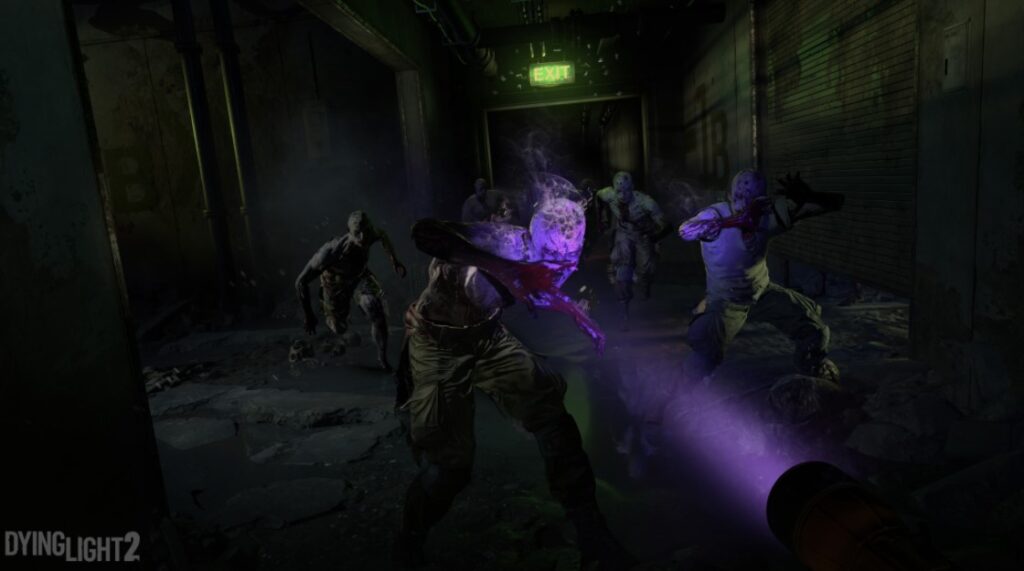
Ordinary buildings contain materials useful for making bandages or enhancing weapons – Dying Light 2 keeps its crafting aspect – while military areas will help you increase your stamina or health. This is almost a requirement, at least on normal difficulty, but it’s never really an obstacle. First of all, because these equipment quests will be quite punctual, and especially because the game takes on a whole new dimension when night falls. The dim light, the dozens of screamers, and the sound environment contribute greatly to the anxious atmosphere of the night sequences, as does the immunity system which adds a sense of urgency to situations that already require you to move quickly. These night sequences are a real success and are quite stressful, helped by a high-level sound design, made of human or infected screams that appear in the background.
As mentioned above, in Dying Light 2, each individual is infected by the virus and is therefore likely to be transformed into a monster. The only way to protect yourself from the spread of the infection and from being transformed into an infected person is to stay exposed to daylight or, at least, to sources of ultraviolet light. This is why, in the absence of these two sources of light, your nocturnal explorations will be subject to a countdown whose duration will increase as your character gains health or endurance. In the first part of the adventure, this race against time requires you to balance between multiple infected, the need to explore, and the limited time you have to live in the dark, which creates a very enjoyable feeling of tension. You’ll have to plan your journeys carefully, make inhalers to reset the countdown, obtain consumables or create UV sources in order to be able to survive and see the daylight again.
This is also where the open-world activities come in handy, as some of them allow you to unlock safe zones, which allow you to rest or simply push back the hordes of infected on your tail thanks to the powerful UV projectors they have. While some of these areas are simple generators to activate, others will be more complex and will require your observation skills to be unlocked. Unlocking a windmill will require you to walk the course, turning on an electric tower will require you to connect generators to their power source via cables of limited dimensions… Techland has made a very notable effort to make this type of open-world activity, usually redundant, enjoyable, especially since they give you significant advantages.
On several occasions, you’ll even have the opportunity to assign strategic resource points to survivors or peacemakers after unlocking them. This will have a direct impact on the area of the city in question, since one or other of the factions will provide useful items to make your life easier. The Survivors will mostly offer mobility bonuses, for example by increasing the number of Ziplines to ensure long-distance crossing, while the Peacekeepers will bring out bombs and other military arsenal to ensure your defense. Assigning a power tower or a castle to a faction has a direct impact on the game’s dialogues and of course, the perception that both groups will have of you, even if it won’t fundamentally impact the main story or the outcome of the campaign. But of course, as you gain experience, these activities will become secondary and the pleasure of doing them will fade away in favor of a truly exciting sense of progression.
AN ENTERTAINING SENSATION OF PROGRESSION

Just like in the first game, you have several ways to gain experience in combat and parkour. First of all, practicing these two arts will allow you to progressively increase your experience gain in one or another field, if you link consecutive jumping or hitting sequences. Then, of course, completing side activities or quests will bring you much higher experience gains and you can distribute talent points in the associated trees. As the tree fills up, your character will become more and more flexible and multi-skilled. Wall run, increased stamina, jumping moves, executions… the parkour and combat mechanics fit together perfectly and Aiden’s mastery will really allow you to make some spectacular runs, especially since Dying Light 2 has added some very well-implemented features to the level design.
In the second part of the adventure, you’ll have a paraglider, which consumes your stamina, but can also be reset if you exploit the hot air currents coming out of some of the ventilation grids. Finally, a grappling hook capable of hanging on everywhere will also be available after a while. The result is a great deal of freedom of movement. You can launch yourself into the heights with the paraglider, jump from pole to pole with the grappling hook and finally attack an enemy after a wall run… In short, if you liked the parkour of Dying Light, you will love the adjustments of Dying Light 2, even if of course you will need some practice to master these sequences.
PERFECTION IS NOT OF THIS WORLD
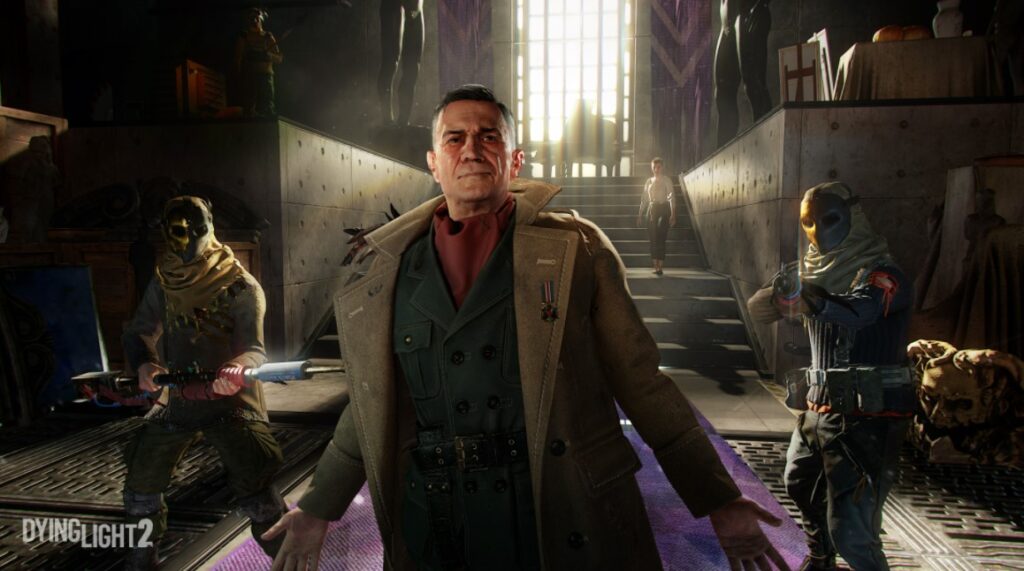
So is this the perfect game? No, not completely. During our play session, which took us more than 50 hours in normal mode, taking the time to do some side content, but still having many points of interest or quests to discover, we were confronted with some technical bugs. While the game is very beautiful, once pushed to its limits, it is quite consuming in resources and still suffers from some aliasing and clipping on the heights. But this is only a minor detail when compared to human artificial intelligence, which should be reviewed. Infiltration sequences are quite painful to run, and fights, although intense, can make you smile when some of the renegades are waiting to get hit straight away, or when they have pathfinding problems.
Finally, on PC and Xbox Pad, we encountered some input problems, where some keys, especially the environment scan, struggled to trigger the associated action, as if they were no longer detected. These problems were quite punctual, just like the display or collision bugs, but still, Dying Light 2 shows a little lack of final touches which is definitely fixable with a patch.
We didn’t encounter any crashing bugs. Note that, as we write these lines, we learned that Techland will deploy a Day One patch that may fix these problems and also add missing voices or dubbing problems that we encountered while playing in the French Version. And while we’re on the subject of weak points, the voice acting is particularly unbalanced. The main characters do well, but some secondary characters are not very convincing. So you should prefer the English version.
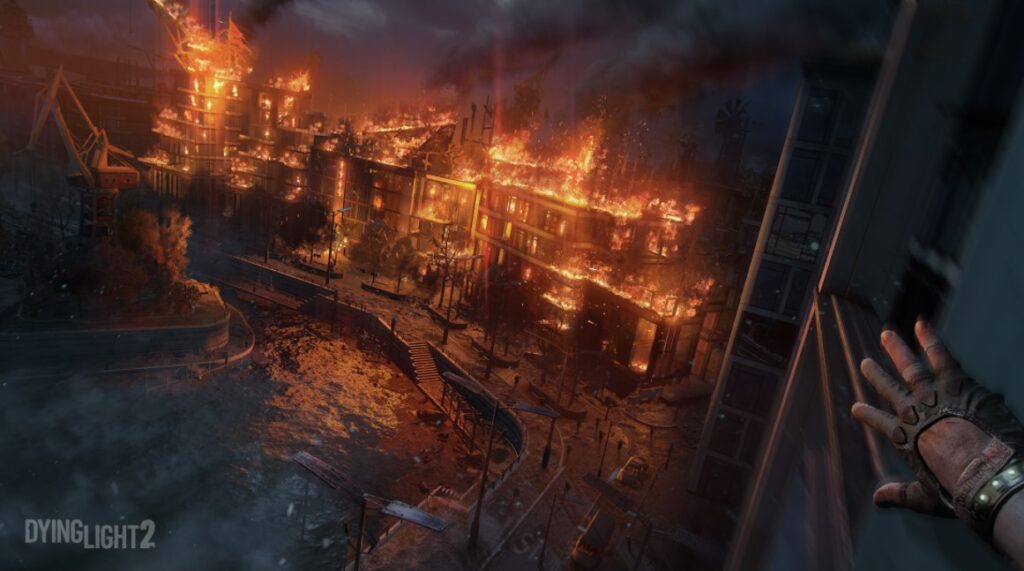
Conclusion
If you were afraid that Dying Light 2 would be a 1.5 version of its predecessor, it is not the case in fact. Dying Light 2 takes all the ingredients that made the success of the first episode, and enhances them, refines them, and improves on them to create a breathtaking, generous, fun, and complete experience that offers memorable moments of courage. The open world is both attractive and well designed, the side activities are well-considered, carefully selected, and useful for the most part, and the game’s storytelling is also reflected in the secondary content, all of which are qualities that can be credited to Techland’s game. In an ideal world, we certainly would have appreciated a more developed AI, a scenario without some clichés, a less rushed ending, a more accurate voice-over, but perfection is far from being a reality, and the bugs that were found can be fixed, so it’s hard to deny the pleasure of this Dying Light, which is a success in its second part.
